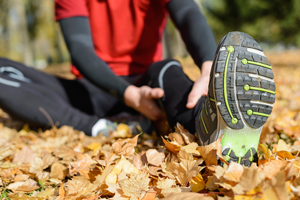Plantar fasciitis causes swelling, redness and pain in the tough, fibrous band of tissue that runs from the heel to the ball on the bottom of the foot.
It can be caused by:

- Wearing shoes with poor arch support or not correct for your arch, or shoes broken down because of too much use.
- Sudden weight gain or obesity.
- Flat feet or high arches.
- Tight calf muscles or Achilles tendon.
- An increase in frequency or distance of walking or running.
- Running on uneven surfaces, long distances and downhill.
The good news is it can be treated and healed easily in most cases.
Pain from plantar fasciitis often starts out mild and increases to a sharp, stabbing sensation most commonly felt on the bottom of the feet after you take your first steps in the morning or after a prolonged period of rest. Pain also may increase with intense activity or from being on your feet too long.
Treatment for plantar fasciitis can take a couple of months or longer before relief is felt. Not everyone will respond to the same treatments, so here are some treatment options:
- Cut back on how often and how long you exercise until the pain lessens.
- Rest and elevate your feet and apply ice packs to the painful area for 15 to 20 minutes, three to four times a day. Or, you can freeze a water bottle, set it on the floor and roll your foot across it from front to back.
- Take an over-the-counter pain reliever if suggested by your health care provider.
- Wear a heal cup or shoe inserts for your specific foot type.
- Wear shoes with good arch support.
You should replace your shoes every six months to one year or with every 300 to 500 miles of usage. Avoid footwear such as flip-flops, which offer no arch support.
Regular stretching exercises are recommended:
- Use a towel to do a calf stretch before getting out of bed in the morning. Sit with your leg straight and put a towel around the ball of your foot. Pull the top of your foot towards your body.
- Do a calf stretch by hanging your heels off the edge of a step or propping your toes against the edge of a wall and bending your knees.
- Do a marble pick-up with your toes. Spread marbles on the floor and return them to the container using your toes.
- Do towel scrunches. Put a towel on the floor and with your heel at the edge of the towel, scrunch up the towel by putting your toes on the towel and curling them.
If plantar fasciitis is left untreated, it eventually may cause other foot, hip, back and knee problems. To prevent recurrence, resist wearing flip-flops or spending too much time barefoot.
Share comments or questions on this information email: sports.medicine@marshfieldclinic.org.
